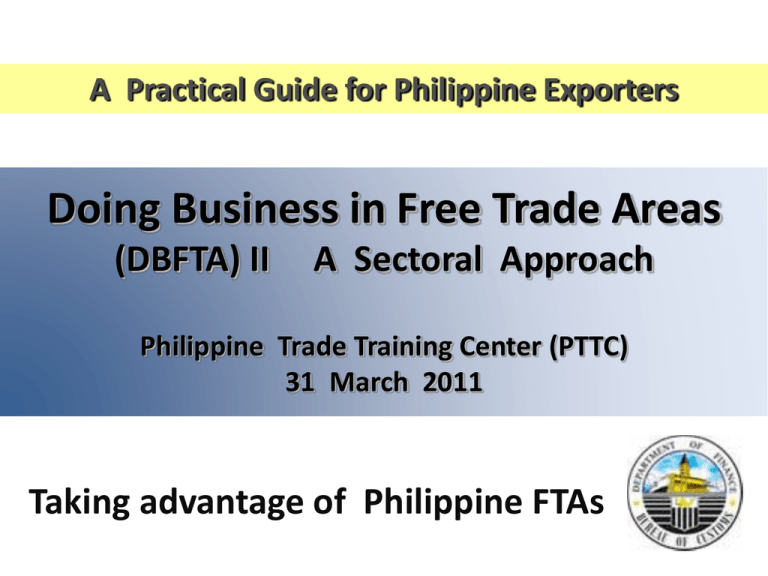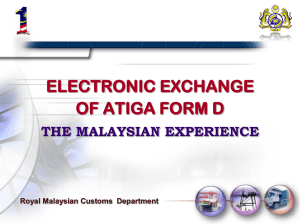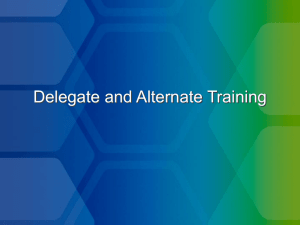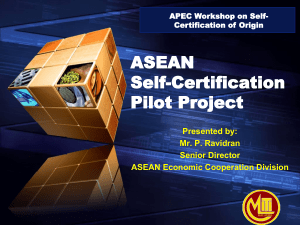Documentary Evidence - Philippine Trade Training Center
advertisement

A Practical Guide for Philippine Exporters Doing Business in Free Trade Areas (DBFTA) II A Sectoral Approach Philippine Trade Training Center (PTTC) 31 March 2011 Taking advantage of Philippine FTAs DETERMINATION of ORIGIN RULES OF ORIGIN Are regulations to determine the Country of Origin “nationality of the goods” • PREFERENTIAL Determine whether imported products shall be subjected to a most-favored nation (MFN) treatment or preferential treatment e.g. ATIGA, ACFTA, AKFTA, AANZFTA, PJEPA, AJCEP • NON-PREFERENTIAL Implement measures and instruments of commercial policy e.g. anti-dumping, countervailing, safeguards Why do we need the Rules of Origin in FTA? To determine whether goods can be considered as originating goods of the contracting countries. To implement trade and industry policies related to EPAs. To promote trade by eliminating/ reducing tariff rates. OBJECTIVES To guide the exporter on the step-by-step processes in securing a Certificate of Origin from BOC To guide Importer in claiming Preferential Tariff Treatment for products covered by Certificate of Origin under Bilateral and Multilateral Trade Agreements ROLE OF THE BUREAU OF CUSTOMS Implementing Agency for the Rules of Origin 1) Issuing Authority 2) Granting and Receiving Authority for Preferential Tariff Treatment Issuing Authority Conducts pre-exportation evaluation of products Issue ruling on the qualification of the product Issue Certificate of Origin Conducts retro-verification procedure Granting Authority Evaluates application for availment of Tariff preferences on products covered by FTA Grants Preferential Tariff concessions for qualified products Request for retro-verification ORGANIZATIONAL STRUCTURE COMMISSIONER OF CUSTOMS INTERNAL ADMINISTRATION GROUP ASSESSMENT & OPERATIONS COORDINATIO N GROUP REVENUE COLLECTION & MONITORING GROUP ADMINISTRATION OFFICE • Human Resource Management Division • Public Information & Assistance Division • Central Records & Management Division • General Services Division • Medical & Dental Division • Training & Development Division • Interim Internal Control Office IMPORT & ASSESSMENT SERVICE • Valuation & Classification Division • Assessment Coordination & Monitoring Division • Warehouse Coordination Division FINANCIAL SERVICE • Statistical Analysis Division • Revenue Accounting Division FINANCIAL MANAGEMENT OFFICE • Accounting Division • Budget Division • Planning & Policy Research Division PORT OPERATIONS SERVICE • Auction & Cargo Monitoring & Disposal Division • Export Coordination Division • Port Operations & Coordination Division COLLECTION DIVISION • Collection Performance Evaluation Division • Liquidation & Assessment Audit Division • Bonds Audit Division LEGAL SERVICE • Ruling & Research Division • Appellate Division • Prosecution & Litigation Division • Tax-Exempt Division MANAGEMENT INFORMATION SYSTEM & TECHNOLOGY GROUP PLANNING & SYSTEMS DEVELOPMENT SERVICE • Planning & Management Information Division • Systems Development Division TECHNOLOGY MANAGEMENT SERVICE • Systems Management Division • Technology Support Division INTELLIGENCE GROUP CUSTOMS INTELLIGENCE & INVESTIGATION SERVICE • Intelligence Division • Investigation & Prosecution Division • Internal Inquiry & Prosecution Division Intellectual Property Unit ENFORCEMENT GROUP ENFORCEMENT & SECURITY SERVICE •Customs Police Division •Warehouse Audit & Monitoring Unit • Risk Management Group 17 District Collection Ports POST ENTRY AUDIT GROUP TRADE INFORMATION & RISK ANALYSIS OFFICE • Trade Information Analysis Division I • Trade Information Analysis Division II COMPLIANCE ASSESSSMENT OFFICE • Audit Division I • Audit Division II • Audit Division III • Audit Division IV • Audit Division V CUSTOMS COLLECTION DISTRICTS 3 Major Ports Port of Manila 14 Provincial Ports Port of Clark Int’l. Airport 33 Sub Ports Port of Subic Ninoy Aquino International Airport Manila International Container Port Port of Legaspi Port of Iloilo Port of San Fernando Port of Batangas Port of Tacloban Port of Surigao Port of Cebu Port of Cagayan de Oro Port of Davao Port of Zamboanga ORGANIZATIONAL CHART COLLECTION DISTRICT II-A: PORT OF MANILA KINDS OF CERTIFICATE OF ORIGIN GSP Form A : Form D : Form E : Form AK : Form JP : Generalized System of Preference ASEAN Trade in Goods Agreement ASEAN China Free Trade Area ASEAN Korea Free Trade Area JAPAN PHILIPPINES Economic Partnership Agreement Form AANZ : ASEAN-AUSTRALIA-NEW ZEALAND Form AJ : White CO : Free Trade Area ASEAN-JAPAN Comprehensive Economic Agreement CO for General Merchandise (non-preferential) What are the Main Elements of RULES OF ORIGIN? I. Origin criteria A. Wholly-Obtained Product B. Product that have undergone substantial Transformation 1. Change in Tariff Classification (CTC) 2. Value-added 3. Specific Process C. Accumulation D. Specific Concepts II. Direct Consignment IIl. Documentary evidence Basic Concepts of Rules of Origin Origin Criteria : A rule needed to determine the country of origin of the product at the time of exporting of the goods. Consignment : A rule is needed to determine whether the goods have lost the status as product of that country or not Procedural Provisions : A rule is needed to specify the procedure whereby the importers prove to the Party that the declared goods qualify as “Produced” in the Party at the time of import Conditions to Receive Preferential Treatment 1. Products shall be specified as eligible for Preferential Treatment (items in concession schedule) 2. Products shall satisfy the substantive conditions on Origin Criteria, Consignment Criteria and Procedural Provisions What are Origin Criteria? Means of determining HOW and WHEN a product can be considered as ORIGINATING from a specific country The core of the Rules of Origin “ORIGINATING” GOODS 1. Wholly-obtained and produced goods Goods made entirely in the exporting FTA Party (e.g. the Philippines) from materials produced in that same country (e.g. goods grown, born and raised, gathered, or extracted in the Philippines) Example: The Philippines’ agricultural exports including seafood harvested within the country, and mineral goods “ORIGINATING” GOODS 2. Goods underwent substantial transformation process Products manufactured from exporting country wholly or partly from imported materials or components, including materials of undetermined or of unknown origin, are considered as ORIGINATING in that country if its materials, parts or components have undergone SUBSTANTIAL WORKING OR PROCESSING there. Types of Goods Underwent Substantial Transformation 1. Change in Tariff Classification Rule (CTC Rule) 2. Value-added rule (VA Rule) 3. Specific Manufacturing or Processing Rule (Process Rule) 4. Co – equal Rule 2. VALUE-ADDED RULE (VA Rule) ROO based on value-added (i.e., value-added rule) measure the extent of manufacturing or processing undertaken in a country by reference to the value added to the good. There are two requirements: 1. the final processing must be performed in a country; and 2. the value added in the country, calculated using a given formula, must satisfy the required threshold The formula may measure local content based on the FOB value, the ex-factory price or the ex-factory cost. Certain cost adjustments may be required. Packaging materials and containers for retail sale, if classified with the good, are included in the calculation of value-added while packing materials and shipping containers are excluded. 3. SPECIFIC MANUFACTURING or PROCESSING OPERATION RULE (Process Rule) ROO based on process ascertain the critical process or element in the manufacture of a good. The country where such a critical process is done or where a critical element is obtained would be the country of origin of the good. 4. CO-EQUAL RULE In any case that a Rule of Origin is a combination of CTC Rule, Regional Value Content Rule or Specific Process Rule, these three criteria are the co equal rule; therefore, any one of these criteria must be satisfied (no priority) is established among the three. COCONUT SECTOR 1 1513.1910 Refined Oil 2 5608.9090 Knotted netting of twine CC = Change in Chapter AANZFTA ATIGA AKFTA ACFTA AJCEP RVC (40) or CC RVC (40) or CTSH WO RVC (40) CTH RVC (40) CC RVC (40) or Textile Rule or CC RVC (40) or CC RVC (40) RVC (40) CC, provided that, where non-originating materials of heading 50.04 through 50.06, 51.06 through 51.10, 52.04 through 52.07, 53.06 through 53.08, 54.01 through 54.06, 55.08 through 55.11 are used, each of the nonoriginating materials is spun entirely in one or more of the Parties. PJEPA CTH except Chapter 8 and 12 CC, provided that, where non-originating materials of heading 50.04 through 50.06, 51.06 through 51.10, 52.04 through 52.07, 53.06 through 53.08, 54.01 through 54.06, 55.08 through 55.11 are used, each of the nonoriginating materials is spun entirely in either Party or a non-Party which is a member country of the ASEAN COCONUT SECTOR H.S. DESCRIPTION ATIGA AKFTA 2009 Top EXPORTS OFAANSFTA COCONUT SECTOR CODE ACFTA AJCEP CC 1203.0000 COPRA WO WO WO RVC (40) 1404.9090 COCONUT SHELL POWDER RVC (40) or CC RVC (40) or CTSH WO RVC (40) CC, provided that, 1513.1910 REFINED OIL RVC (40) or CC 4402.0000 OF COCONUT SHELL NOT AGGLOMERA RVC (40) or CTH 5305.1100 BALES COIR RAW COCONUT 5305.1900 COCO PEAT OTHER COCONUT RVC (40) or CC RVC (40) or CTSH RVC (40) or CTSH RVC (40) or CTH RVC (40) or CTH RVC (40) or CC where nonoriginating materials of heading 50.04 through 50.06, 51.06 through 51.10, 52.04 through 52.07, 53.06 through 53.08, 54.01 through 54.06, 55.08 through 55.11 are used, each of the nonoriginating materials is spun entirely in one or more of the Parties. Change in Tariff Classification CC – Change of Chapter – Change to this Chapter from any other Chapter CTH – Change of Tariff Heading – Change to this heading from any other heading CTSH – Change of Tariff Subheading – Change to this subheading from any other subheading Based on HARMONIZED SYSTEM (HS) 1. Change in – tariff classification Rule (CTC Rule) Philippines Coconut / Copra H.S. 801.19 Exported Refined Oil H.S. 1513.19 Australia A Philippine oil factory buys copra from various farmers as a raw material for the production of a refined oil to be exported to Australia. Continued… Continued… For purposes of determining origin of the refined oil: • The coconut (801.19) is an originating material. The heading of the finished product (refined oil) 1513.19 is different from that of the coconut. The required change has occurred. The product refined oil is an ”originating goods” of the Philippines, hence this qualify for PREFERENTIAL TARIFF TREATMENT. Continued… The HS code of refined oil is 1513.19 and its origin rule under ATIGA is “A regional value content of not less than 40 percent; or A change to subheading 1513.19 from any other. The rule requires that the 6-digit (i.e. subheading) code of the refined oil be different from those of the materials used in its production in the Philippines. For purposes of determining the Regional Value Content of the refined oil: • The COCONUT is originating material. • The FOB price of the refined oil is $ 140. Using the formula, • R.V.C. of Refined oil = FOB $140 — 0 (Non Originating Material) FOB $140 (Local materials) = 1 x 100 = 100 % • The “refined oil” as manufactured in the Philippines using originating materials satisfies the regional value content as mandated under the Rules of Origin thus it is an “originating” good of the Philippines. RULES OF ORIGIN OPERATIONAL PROCEDURES OPERATIONAL CERTIFICATION PROCEDURES (OCP) FOR ROO Step 1: APPLICATION FOR PRE EXPORT VERIFICATION Step 2: PRE-EXPORT VERIFICATION Step 3: CO APPLICATION MANUFACTURER / EXPORTER Applies for the pre-export verification of the origin of goods ISSUING AUTHORITY / BODY Conducts the pre-export examination MANUFACTURER / EXPORTER Applies for a CO. Submits the result of pre-export verification and appropriate requirements. ISSUING AUTHORITY / BODY Step 4: CO ISSUANCE Issues the CO. Retains duplicate copy of the CO. MANUFACTURER / EXPORTER Sends original CO to the IMPORTER. Retains the triplicate copy of the CO. The Requirements for PRE-EXPORT EVALUATION 1. Written request for evaluation to be submitted at least 5 days prior to exportation 2. Complete list of all materials (local and imported) used in the production 3. Breakdown of cost element 4. Import and Export declaration 5. Production Flowcharts 6. Company profile 7. Other documents to support originating status of the product 8. Photo of production process REQUIREMENTS FOR THE ISSUANCE OF CO 1. 2. 3. 4. Copy of approved Export Declaration Copy of Bill Lading / Airway Bill Commercial Invoice Copy of Export Permit for regulated products PROCEDURES FOR THE ISSUANCE OF CERTIFICATE OF ORIGIN 1. Exporter presents CO Declaration to the Export Division 2. Trade Control Examiner conducts evaluation and verification documents 3. Trade Control Examiner checks if the product is included in the list covered by the Preferential Tariff 4. Trade Control Examiner submits findings to the Chief, Export Division 5. Chief, Export Division signs Certificate of Origin Import Clearance Procedure for shipment covered by Certificate of Origin FORM D/E/AK/JP/AANZ/AJ Check by Preferential Rate Unit (PRU), Formal Entry Division (FED) for: Formal Compliance Presentation Time Compliance Origin Criteria Compliance Retroactive Verification of Certificate of Origin FORM D/E/AK/JP/AANZ/AJ Verification of Form D/E/AK/JP/AANZ/AJ with issuing office abroad Reasonable doubt exists: authenticity of the documents accuracy of the information regarding the origin of products or certain parts ON-SITE VERIFICATION Customs Authorities in the importing country can conduct verification in the exporting Party: If not satisfied with the verification conducted by the issuing authority in the exporting party under exceptional cases. a. Systematic Fraud b. Cost of the verification is less than the revenue that can be recovered as a result of the verification Pending result of verification of the CO: The shipment may be granted provisional release under the following term: Importer to post a guarantee in the form of either a manager /cashier check or a company postdated check Amount equivalent to the difference of the duties and taxes due based on MFN rates and the preferential rates MATRIX OF OPERATIONAL PROCEDURES OF VARIOUS FTA-ROO ATIGA ACFTA AKFTA AANZFTA JCEP I. ISSUING AUTHORITIES Government authorities: Customs–PHI,SGP Ministry of Commerce- THA, KH, LA and MM Ministry of Trade – IDN, MAL, VN Ministry of Foreign Affairs & Trade BRU Government authorities China – Customs Authority designated by the governmentKorea Chamber of Commerce Korean Customs Service Australia Chamber of Commerce and Industry New Zealand Chamber of Commerce and Industry Japan Chamber of Commerce and Industry MATRIX OF OPERATIONAL PROCEDURES OF VARIOUS FTA-ROO ATIGA ACFTA AKFTA AANZFTA AJCEP II. PRE EXPORT EXAMINATION Yes, Exporter to Same as in submit ATIGA documents as basis for supporting evidence of origin Same as in ATIGA Same as in ATIGA Yes, as provided in the Implementing Regulations MATRIX OF OPERATIONAL PROCEDURES OF VARIOUS FTA-ROO ATIGA ACFTA AKFTA AANZFTA AJCEP III. EXPORTER APPLICATION Written application to issuing authorities with prescribed minimum data Same as in ATIGA Same as in ATIGA Same as in ATIGA Written application to issuing authorities with prescribed minimum data and proof of origin of the goods MATRIX OF OPERATIONAL PROCEDURES OF VARIOUS FTA-ROO ATIGA ACFTA AKFTA AANZFTA AJCEP IV. CERTIFICATE OF ORIGIN Unique Certificate number Origin plus two copies Official Seal / signature of issuing body Specified minimum data requirements Issued within 3 days of export Unique Certificate number Origin plus three copies Unique Same as in Certificate ATIGA number Origin plus two copies Official Seal / signature of issuing body Official Seal / signature of issuing body Dedicated form / Specified data minimum data requirements requirements Issued within 3 days of export Same as in AKFTA MATRIX OF OPERATIONAL PROCEDURES OF VARIOUS FTA-ROO ATIGA ACFTA AKFTA AANZFTA AJCEP V. PERIOD OF VALIDITY 12 Months Normally 4 months 6 months when transhipped through a nonParty 6 months 12 Months 12 Months MATRIX OF OPERATIONAL PROCEDURES OF VARIOUS FTA-ROO ATIGA ACFTA AKFTA AANZFTA AJCEP VI. RETROACTIVE ISSUANCE Yes, up to 12 Months Same as in ATIGA Same as in ATIGA Same as in ATIGA Same as in ATIGA MATRIX OF OPERATIONAL PROCEDURES OF VARIOUS FTA-ROO ATIGA ACFTA AKFTA AANZFTA AJCEP VII. ACTION BY IMPORTER Submit original copy of Certificate at time of import declaration Submit original Same as in copy of ATIGA Certificate plus triplicate copy at time of import declaration Triplicate copy sent back to issuing authority in exporting country Same as in ATIGA Same as in ATIGA MATRIX OF OPERATIONAL PROCEDURES OF VARIOUS FTA-ROO ATIGA ACFTA AKFTA AANZFTA AJCEP VIII. NO CERTIFICATE REQUIRED No Same as in Same as in certificate ATIGA ATIGA required for goods valued at less than $200 FOB Same as in ATIGA Same as in ATIGA MATRIX OF OPERATIONAL PROCEDURES OF VARIOUS FTA-ROO ATIGA ACFTA AKFTA AANZFTA AJCEP IX. BACK TO BACK CERTIFICATE Yes, required in transhipment cases Movement Certificate Effectivity Jan 2011 Same as in ATIGA Same as in ATIGA Same as in ATIGA MATRIX OF OPERATIONAL PROCEDURES OF VARIOUS FTA-ROO ATIGA ACFTA AKFTA AANZFTA AJCEP X. VERIFICATION PROCEDURE Request shall be Same as in made in writing ATIGA and accompanied with the CO also specify the reason for retro verification Same as in ATIGA Same as in ATIGA Same As in ATIGA . MATRIX OF OPERATIONAL PROCEDURES OF VARIOUS FTA-ROO ATIGA ACFTA AKFTA AANZFTA AJCEP XI. RECORD KEEPING Issuing body, Same as in exporter and ATIGA importer to keep relevant record for 3 years Same as in ATIGA Same as in ATIGA Same as in ATIGA SAMPLE CO FORM Reminder: The Certificate of Origin, once duly certified by an authorized official of the Philippine Government, becomes a public document. Anyone who furnishes or causes to be furnished false information in any material particular shall be liable and punishable under the Revised Penal Code of the Philippines and other related laws.






